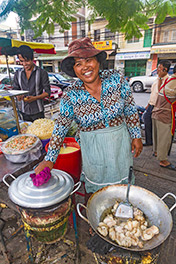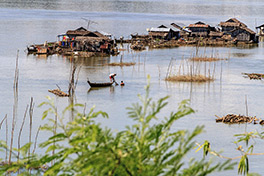| |
Yes, Cambodians eat a lot of rice. In fact, there’s a Cambodian phrase which asks if you’ve eaten, but actually translates to “Have you yet eaten rice?”
So expect a LOT of rice on a tour through Cambodia.
Beyond that, Cambodian food is much like Thai, but nowhere near as hot. And a bit like Vietnamese, but heavier. The bottom line? If you aren’t sampling the local cuisine in Cambodia, you are missing one of the best parts of your trip.
The national dish is something called amok—a thick stew in which curry paste is the binding ingredient. Amok has meat, fish or chicken, lime leaves, cabbage and coconut, and is usually served in a bowl lined with a banana leaf. Each region, heck, each town, and, actually, each restaurant, seems to have its own version. |
|
 |
| |
|
Woman on Phnom Penh street cooks pork and shrimp to sell |
| |
|
|

|
|
In Phnom Penh, we did what everyone does—went to the waterfront along the Mekong River, found a menu we liked, climbed to the restaurant’s second floor balcony and ordered, of course, amok.
The restaurant, Khmer Saravan, was latter-day hippie, with enthusiastic...very enthusiastic...comments scribbled in magic marker on construction paper that lined the walls.
We sat there in the city’s heated steaminess, fanning ourselves and sipping coffee smoothies between bites of the amok. A perfect city dinner. And our total bill, including three coffee drinks and the two bowls of amok, came to about $10. Cambodia is one of the last places on earth where the US dollar goes the distance. |
| Rice wine with plastic model of cobra snake sold as a souvenir sitting on a painting of a local rural Cambodian scene. The real thing is sold to 'cure' coughing and for virility. |
|
We ate in fancy hotels. We ate at street stalls. We ate at a private home. We ate sitting on a straw mat in a night market and best of all, we nibbled our way through sidewalk cafes in the country’s tourist mecca, Siem Reap. Yes, we were careful about water. And thanks to the heat, we consumed an ocean of iced coffee, which in this part of the world is thick, chocolatey and comes with an inch of sweetened condensed milk on the bottom. |
The trick to the ice is to ask if it’s clean. One way to tell is if the ice cubes are uniform. It usually means boiled or bottled water was used to make ice in trays. The other stuff is usually local water frozen into a block and chipped with a pick. So the ice comes in little shards. Sad to say, we learned this the hard way.
But back to the food.
| |
|
At Phnom Penh’s night market, there was a welter of meats on a stick. We kicked off our shoes, settled onto one of the straw mats and chowed down on grilled pork and something (I still don’t know what) fried in a thin pastry.
The private home was on an island off Kratie called Koh Trong. This island is a slice of Cambodia’s rural past. There are no cars. People get around either by ox or horse cart, bicycle or, in a few cases, motorbikes. It was a great way to see how the majority of Cambodia lives outside its cities. |
| |
Sour soup, a Khmer dish that can have a variety of meats. In this case, the soup has chicken, lime leaves and banana flowers |
As we went on from place to place, we realized clear soups with a hint of lime and lots of vegetables seemed to work best in that heat. Light clear soup goes down easy and is tasty. |
And while our home stay wasn’t the private experience we expected (we wound up sharing it with a dozen French tourists, sleeping on thin mattresses all together in one huge room), dinner that night was divine...morning glory greens stir fried with chunks of pork, soup with chunks of fish and the local favorite fruit, pomelo. Pomelos look like green grapefruit. They’re not as sweet nor as juicy but in that climate, they are perfect.
Um, yes, the heat. We carefully planned our trip for the alleged cool, dry season. But it turns out we were a month early, despite what Google and all the guide books said.
“You’ve heard of this global warming...yes?” our guide asked. “Our weather hasn’t been right for five years.”
I didn’t think it was possible to sweat that much, but the country runs on bottled water. And so do all the visitors. I lost count after half a dozen by the middle of each day.
|
Buddhist monk visiting Angkor Wat, the largest Hindu temple complex in the world. The temple was built by King Suryavarman II in the early 12th century and was the capital of the Khmer Empire. It was originally Hindu, then became Buddhist. It has become a symbol of Cambodia, appearing on its national flag, and is the country's prime attraction for visitors. |
|
From the island, we made our way to Siem Reap, ground zero for Cambodia’s 2.8 million yearly tourists. The draw is Angkor Wat and its surrounding temples. Honestly, while everyone flocks to the main temple, the best of all is Ta Prohm, also called the jungle temple because ficus trees have swallowed the ruins. The highlight is one massive series of roots across a particularly picturesque building which has been nicknamed the Tomb Raider ruin. Unfortunately, its claim to fame comes from a truly awful, based-on-a-video-game movie staring Angelina Jolie. But the ruin and its tangle of roots is beyond neat.
| Octopus Root tree at Ta Prohm on the Angkor complex in Cambodia. Ta Prohm is also called the jungle temple because its buildings are slowly being covered by the roots of spung trees (Tetrameles nudiflora). Built in the late 12th and early 13th centuries. it was founded by the Khmer King Jayavarman VII as a Buddhist monastery and university. The combination of trees growing out of the ruins and the jungle surroundings have made it one of Angkor's most popular temples with visitors. The temple became even more popular when it was used as a location in the 2001 Hollywood film Tomb Raider starring Angelina Jolie. |
 |
That evening, we did what everyone in Siem Reap does...caught a $2 tuk tuk (think rickshaw pulled by motorcycle) and went to the night market.
The night market here is the center, the mecca, of Siem Reap’s evening tourist scene. In other Cambodian cities, the markets are really for locals...hot, sweaty, claustrophobic places jammed with pots and pans, cheap clothing and other goods of daily life. After the markets of Phnom Penh and Kratie, I was beginning to think there really was nothing for a tourist to buy in this country.
|
|
But in case anyone misses the point in Siem Reap, there are huge, glowing, three-foot-high neon signs hanging across the street…every 50 feet or so. I was looking for a pair of lightweight pants. Something that might fit me (I’m not small) in a country where size zero is considered large. But, I did find them, for $7 apiece. And they look great. Also a t-shirt, scarves, earrings and assorted other whatnots. You could, if you tried very hard, spend serious dough here. There are silver trinkets and wall hangings and paintings and furniture to die for and this quilt shop where they make bedding to order.
Artisan Angkor, a workshop that trains young, uneducated and sometimes disabled Cambodian youths in craftwork including wood carving, lacquerware, silver work and silk painting. Here, young men work on silver. |
| |
|
|
|
|
| |
|
|
|
|
| |
Young boy rocks his baby sister in hammock in their simple house on Koh Trong Island across the Mekong River from Kratie, Cambodia.
|
|
Making rice noodles on Koh Trong Island. Rice is soaked overnight, then squeezed into a paste and pounded into a snooth dough. Then it's put into molds and squeezed through to form noodles. |
|
Mostly, the fun is to just wander and window shop. Maybe try a 'doctor fish' tank where tiny carp nibble dead skin off your feet (much less icky than it sounds but VERY ticklish). And then eat. Though eating on the street might seem adventurous, the food is all either grilled over coals or cooked to a crisp in a wok. I figured the heat was enough to kill just about anything potentially harmful. One night, we had stir fry. Another it was ribs. Just about everything is priced in US dollars and costs about $1.50. The exception was the whole, stuffed red snapper which fed us both and ran $6. We topped that off with a young coconut. They cut a hole, add a straw and you quench your thirst.
| |
|
|
|
|
| |
Tourist woman gets doctor fish 'massage.' Tiny fish nibble dead skin off a person's feet. It tickles like mad. In Siem Reap's Night Market, $2 US gets you a can of beer and 20 minutes with the fish in a tank. |
|
Market in Kratie, Cambodia
|
|
Finally, shopped out and well-fed, we hailed another tuk tuk and headed back to our hotel, where the swimming pool awaited.
Cambodia has two seasons...wet and dry. Avoid the wet season (June - November) at all costs. Many roads, even main ones, are dirt and under construction. The mud can be axle-deep. Cambodia is not far from the Equator. It is HOT and steamy and temperatures can reach 100 degrees, especially during wet season. If you can, stay in hotels with swimming pools.
Don’t expect slick organization. This country was taken back to the stone age by the Khmer Rouge in the late 1970s. Most people over 40 don’t even know what year they were born. It’s been a slow recovery. But, cell phone signals are everywhere.
The US dollar is the main currency. There really is no need to change large amounts of money. But make sure to bring a LOT of small bills ($1s and $5s) and they must be in perfect shape. No one will take any bill if it has the smallest rip. Ask for new, crisp bills at your bank.
Cambodia tourism: www.tourismcambodia.com/
Travel Agent: www.redlanternjourneys.com
| |
 |
|
Floating Vietnamese fishing village at the southern tip of Koh Trong Island across the Mekong River from Kratie, Cambodia. To get around laws forbidding Vietnamese from owning land in Cambodia, these Vietnamese families live on floating houses just offshore. |
|
|
|